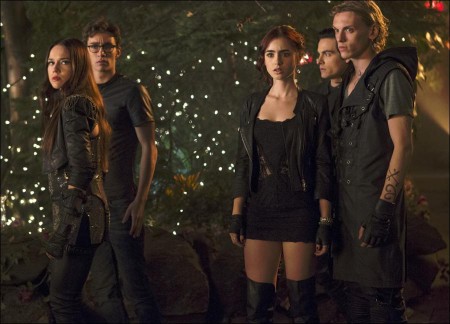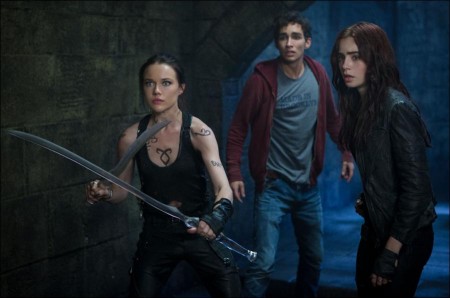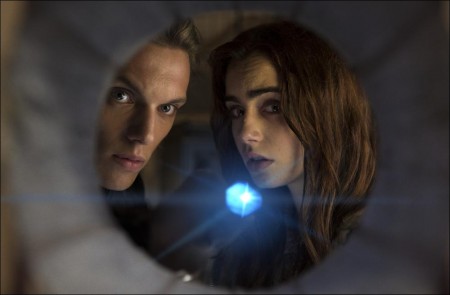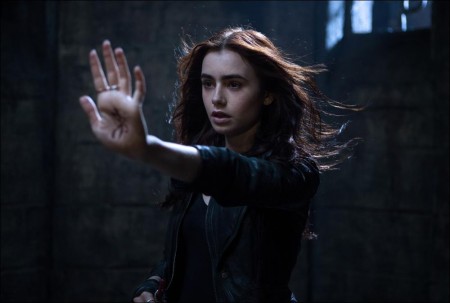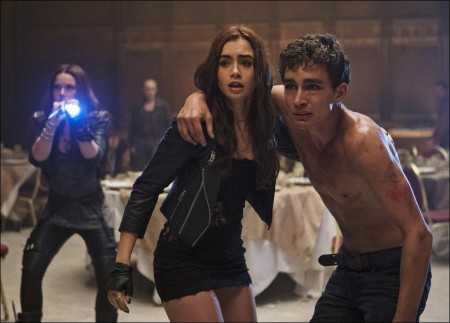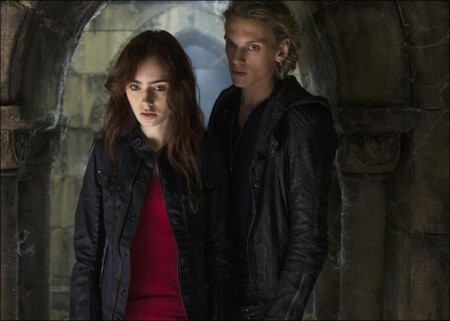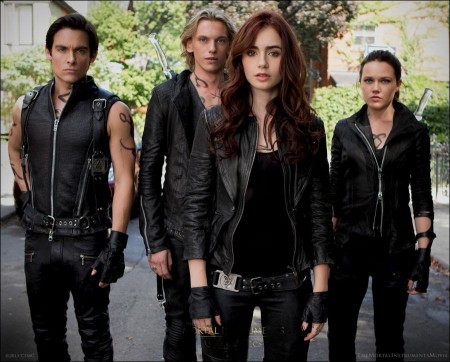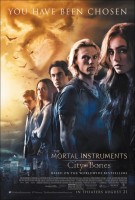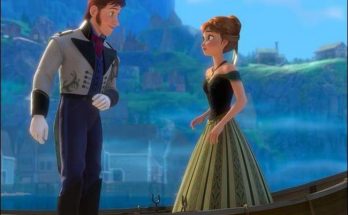Taglines: You have been chosen.
Set in contemporary New York City, a seemingly ordinary teenager, Clary Fray (Lily Collins), discovers she is the descendant of a line of Shadowhunters, a secret cadre of young half-angel warriors locked in an ancient battle to protect our world from demons. After the disappearance of her mother (Lena Headey), Clary must join forces with a group of Shadowhunters, who introduce her to a dangerous alternate New York called Downworld, filled with demons, warlocks, vampires, werewolves and other deadly creatures. Based on the worldwide best-selling book series.
The Mortal Instruments: City of Bones is a German-Canadian action-adventure science fantasy film based on the first book of The Mortal Instruments series by Cassandra Clare. The story takes place in an urban and contemporary New York City. Directed by Harald Zwart, the film stars an international cast, including Lily Collins, Jamie Campbell Bower, Robert Sheehan, Kevin Zegers, Jemima West, Godfrey Gao, Lena Headey, Jonathan Rhys Meyers, Aidan Turner, Kevin Durand, and Jared Harris. It was released in theaters on August 21, 2013.
Production Notes (2013)
A seemingly ordinary young woman discovers a hidden world and an extraordinary destiny in The Mortal Instruments: City of Bones, the eagerly anticipated big-screen adaptation of the first book of Cassandra Clare’s blockbuster fantasy adventure series, The Mortal Instruments.
Clarissa “Clary” Fray (Lily Collins) has been living quietly in Brooklyn for as long as she can remember, when she suddenly begins to see startling and seemingly impossible things. Just as suddenly, her single mom (Lena Headey) disappears after a violent struggle. As she and her best friend Simon (Robert Sheehan) search for her mother, Clary begins to uncover the dark secrets and darker threats in the hidden world of the Shadowhunters, angel-human warriors who have protected humanity from evil forces for centuries.
Surrounded by demons, warlocks, vampires, werewolves and other supernatural denizens of the Shadow World, Clary joins forces with young Shadowhunters Jace (Jamie Campbell Bower), Isabelle (Jemima West) and Alec (Kevin Zegers) to locate and protect an ancient Cup that holds the key to her mother’s future. Discovering abilities and courage she never knew she possessed, the young woman surprises even herself as she proves to be a formidable opponent against an array of deadly adversaries.
About the Production (2013)
In 2007 author Cassandra Clare introduced young adult readers to the reluctant warrior, Clary Fray, in The Mortal Instruments: City of Bones, the astonishing first entry in what would become a fantasy-adventure empire. In Clare’s carefully constructed magical world, a young woman finds herself surrounded by warlocks, vampires, werewolves, demons—and the mysterious Shadowhunters, a hidden race of angel-human hybrids who secretly protect humankind from the ultimate evil.
Clare began writing her New York Times, USA TODAY, Wall Street Journal, and Publishers Weekly best-selling series of young adult novels in 2003. “I’ve always been a huge fan of fantasy and epic stories of good and evil,” she says. “I wanted to write a coming-of-age story with a girl at its center, which I don’t see very often, and I decided to set it in New York City, because I had just moved there and fallen in love with its beautiful and amazing history.”
Four years later, The Mortal Instruments: City of Bones hit the bookshelves and became a worldwide phenomenon, launching not just five more novels featuring Clary Fray and her Shadowhunter comrades in The Mortal Instruments saga, but three more multi-part series set in Clare’s brilliantly imagined Shadow World as well: The Bane Chronicles, The Infernal Devices and The Dark Artifices.
The Mortal Instruments: City of Bones was optioned for film in 2009, something Clare says she dreamed of but never thought would really happen. “It’s been quite a journey from the kernel of the idea of the book to the production of the film,” Clare says. “And it’s been surreal. When you write a book, you hope maybe someday it’ll be a movie, but you don’t count on it. I still can’t quite believe it.”
Producer Robert Kulzer read Clare’s The Mortal Instruments series at the suggestion of his colleagues, Bob Shaye and Michael Lynne, producers of blockbuster movies including The Lord of the Rings franchise. “When you read the novels, you discover a new world,” says Kulzer. “I found myself wanting to spend more time with these characters as they go on this incredible journey of discovery. There are so many surprises contained in this world and we want to create a similar sense of wonder in this movie.”
Kulzer shared his find with Don Carmody, with whom he has produced the five hugely successful Resident Evil movies. “Since the success of the Twilight movies, every movie producer has been trying to find their own equivalent,” Kulzer says. “After reading these books, we felt they had the potential to become a huge franchise.”
While Carmody was unfamiliar with the young-adult fiction market, he had a panel of experts close at hand. “It turned out that my teenage daughters are huge fans of the books,” the producer says. “They had grown a bit blasé about the movies I make, but this made them take notice. The Mortal Instruments is what they really want to see on screen. When I started checking around and realized how big the audience was for the novels, I enthusiastically came on board.”
The books have been translated into 36 languages with more than 24 million copies in print worldwide. A sweeping epic that spans centuries and continents, the series has inspired legions of dedicated fans, with whom Clare keeps in close contact through personal appearances and social media.
“As an author, one of the most amazing parts of the experience has been to be able to create a world that started off in my head and that so many other people now want to live in,” she says. “I try to stay in touch with them as much as possible online, through book groups, through signings and traveling the country. It’s been wonderful to be able to share the excitement with people who are as involved with the story as I am. They love the characters like family and now they are fully embracing the film’s actors as their avatars.”
As compelling as the fantasy elements of the books are, Carmody believes the appeal lies deeper. “It’s all about a young woman discovering who she really is,” he says. “It’s a brilliant premise and a great yarn, but it addresses themes that young adults are particularly interested in, because they are in the process of finding themselves.”
The producers spent two years developing the script, always keeping in mind that Cassandra Clare’s legions of dedicated fans were watching the process closely. “We had to be very careful when we altered the narrative or made changes in a character,” Carmody says. “The movie had to be as true to the books as we could possibly make it.”
Screenwriter Jessica Postigo Paquette was tasked with drafting three chapters in what is envisioned as a major franchise with an enviable heroine. “When I first read The Mortal Instruments, I fell in love with Clary Fray,” says Postigo. “She is no damsel in distress—in fact, she kicks ass. She is thrust into this parallel world that no one would ever have imagined even existed and handles it fearlessly.”
“I also love the realistic urban setting,” says Postigo. “Clary lives in Brooklyn and her life is not delicate or precious in any way. You want to know more and more about the characters. Despite having lived with them for years now, I never tire of them. I want to hang out with them.”
Postigo says her first responsibility is to Clare and the books’ fans. “It was very important for me to protect Cassandra’s baby,” says Postigo. “That’s how I saw it. I have so much respect for the world she’s created. The Mortal Instruments books are very different from any other young adult novel I’ve read.”
She was careful to seek the author’s counsel along the way. “Cassandra was an integral part of the process,” says Postigo. “We consulted her often while we were developing the script. She was always very understanding of our concerns and sometimes had a solution we hadn’t considered. She has such a strong, beautiful voice and she’s very smart about the way she chooses to collaborate.”
Clare also provided the filmmakers with an intimate understanding of her readers. “The fans have been very supportive,” says Carmody. “I know it helped that Cassandra was part of the process. Nobody knows this story like she does. She was extremely helpful with casting and with helping us communicate with the fans.”
With the writing process underway, finding the right director became the next step in the equation. “We were really looking for something very specific in our director — someone who had already worked in the genre world and knew how to manage the fantastical elements of the book with the special effects, and create an original world.
When Harald Zwart, fresh off the enormously successful remake of The Karate Kid starring Jaden Smith, came in to meet with the producers, they realized he was the right director for the film – approaching the material, not from the genre world as they had anticipated, but from a grounded, character-specific perspective. Says Kulzer, “Harald had fallen in love with the characters and the world,” says Kulzer. “He wanted to recreate them just as they are in the book. Harald had a whole folder full of tear sheets and boards that he had put together. He had envisioned the characters, the setting, the color palette, even the magic, in such incredible detail.”
After a single two-hour meeting, Zwart was hired. “I said, Harald, I get the feeling you really want to do this movie,” Kulzer says. “He agreed to drop everything else he was working on and focus on prepping this film. He soaked up the world, reading all of the fan blogs to learn what they like and don’t like. If he had questions about anything, he went directly to Cassandra, which made it a very transparent and fluid process, because she is so intimately connected to the fans. If she mentioned any aspect of the film to them, we immediately had thousands of responses.”
The director says he was drawn to the excitement and the visual possibilities of the story, but his strongest connection was to the characters, especially Clary. “In some ways it’s really a detective story about a young woman searching for something that is lost,” he says. “On the way, she discovers that much of what she’s believed all her life is not true. Every day, the character has a ‘what?’ moment that turns what she thought was true upside-down. But Clary is a very powerful young lady and she takes control of her own life. One of the things I love most about the character is that when someone tells her not to do something, you know she’s probably going do it.”
Zwart and Clare made a strong connection and worked closely together to develop a cohesive world for the story. “The first time I met Harald in Los Angeles, he launched into all these questions,” says Clare. “It was so much fun talking to someone for hours about something that I’ve thought about almost exclusively for seven or eight years. It’s very real to me at this point. He didn’t have any experience with fantasy, so he was really fascinated by the rules and systems that you have to adhere to once you establish them. In Harry Potter, we know you have to point a wand and say a word to make magic. The magic in these books is completely different, but it is just as consistent.”
Most importantly to Clare, Zwart was completely attuned to the emotional lives of the characters. “In this genre, it is easy to get caught up in the visuals, and he definitely understands that aspect. But he knows that no matter how cool the movie looks, it’s no substitute for rich inner lives and emotional connections between the characters. Harald is a great director for the project because he is extremely interested in all the relationships: familial, friendship and romantic. That makes it feel real.”
Zwart also sought Clare’s advice on the best ways to fit the sprawling narrative into the limited length of a feature film. “When you adapt a very popular book, you have to make some difficult choices,” Zwart says. “You have to give up certain things for all kinds of reasons. Perhaps something doesn’t work for the logic of the movie, or it’s a stumbling block to moving the story forward, or simply for budgetary reasons. We did our best to preserve what’s really important, and thankfully, Cassandra was very supportive of the choices we made.”
Clare sounds more like a fan than a best-selling author when she speaks about viewing the finished film. “To be able to actually see the City of Bones, the greenhouse, the Institute, Java Jones, Clary’s apartment—all these places that I have described in the books, is an amazing experience,” marvels Clare. “The fans will finally get to meet the characters that they’ve come to love.”
Inside the Shadow World (2013)
In The Mortal Instruments book series, the world we know holds within it another, hidden world populated by magical beings engaged in a constant struggle of good against evil. Known as the Shadow World, it contains mysteries that go back a thousand years to a time when darkness was threatening to engulf the earth.
Ten centuries ago, the Black Death ravaged Europe and endless Holy Wars tore apart the Middle East. According to Cassandra’s Clare’s elaborate and meticulously plotted mythology, demonic forces trying to destroy humanity and take over the world for themselves were behind this strife.
Fearing that evil was about to triumph over good, the Angel Raziel took desperate measures. He mixed his blood with the blood of men in a mysterious crystal goblet. Anyone who drank from this Mortal Cup became part of a race of half human-half angel hybrids known as Nephilim or, more commonly, the Shadowhunters.
This singular race, gifted with great strength and magical abilities, has been protecting the human world against demons ever since. That battle has been ongoing in the Shadow World, although ordinary humans live their entire lives without ever knowing it exists.
“The Shadow World is not an alternate universe,” says producer Don Carmody. “It’s right here, right now. Humans just don’t see it, unless they are Shadowhunters who are there to control the demons and other creatures when they get out of hand and try to cross over into our world.”
The Shadowhunters pursue their enemies relentlessly, without thought for their own safety. “Their selflessness is what fascinates me,” Carmody says. “It’s a very difficult life. They’re constantly in danger of being hurt or killed themselves, yet they never think twice about stepping in when a demon crosses the line.”
For all their strength and unusual abilities, the Shadowhunters remain mortal, with all of the frailties that implies. “It’s important to remember that they are humans with human emotions and a thankless life,” says Clare. “Humans don’t even know they exist, much less risk their lives daily.”
Their primary job is fending off demons, the immortal source of everything evil, that continually try to wrest control of the earth from humans. These inter-dimensional beings, who travel from world to world destroying everything in their path, are divided between lesser and greater demons, with dozens of sub-species. When they are ‘killed,’ they do not actually die, but rather return to their home dimension where they exist in a weakened state until they recover from their wounds.
“Sometimes demons are disguised as other humans and sometimes they’re simply invisible to the human eye,” Clare explains. “They travel through the world, murdering people, taking over their bodies and destroying what has been created. Shadowhunters are our only protection against these predators.”
The Shadow World teems with other supernatural creatures, also known as Downworlders. Downworlders include warlocks, faeries, vampires and werewolves, each with their own unique histories and abilities.
Warlocks, like Clary Fray’s protector Magnus Bane, are the offspring of humans and demons, often conceived through trickery. Also known as Lilith’s Children, they are immortal and their demon ancestry enables them to perform magic. They can be male or female and are the most powerful of the Downworlders.
Vampires and werewolves are humans who have been infected by demonic viruses. In werewolves, the infection can be passed on through a werewolf bite or from parent to child. Their ability to shape shift from human form to wolf initially depends on the phase of the moon, but with experience, a werewolf can learn to control that power. They live in packs and the New York clan is led by Luke Garroway, who is a close friend of Clary Fray’s mother, Jocelyn.
Vampires, also known as the Night Children, are blood drinkers who must hunt between sunset and sunrise. A human can be transformed into a vampire by drinking vampire blood and then being drained of blood by a vampire. Traditionally, vampires and werewolves are mortal enemies, and both were formerly at war with the Shadowhunters, but an uneasy accord is now in place.
The Mortal Instruments: City of Bones (2013)
Directed by: Harald Zwart
Starring: Lily Collins, Jamie Campbell Bower, Robert Sheehan, Kevin Zegers, Lena Headey, Kevin Durand, Aidan Turner, Jemima West, Jared Harris, Jonathan Rhys Meyers
Screenplay by: Jessica Postigo Paquette
Production Design by: François Séguin
Cinematography by: Geir Hartly Andreassen
Film Editing by: Jacqueline Carmody
Costume Design by: Gersha Phillips
Set Decoration by: Patricia Larman
Music by: Atli Örvarsson
MPAA Rating: PG-13 for intense sequences of fantasy violence and action, and some suggestive content.
Studio: Sony ScreenGems
Release Date: August 21, 2013
Visits: 50
